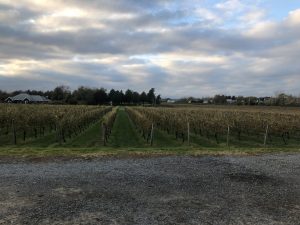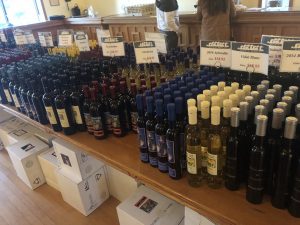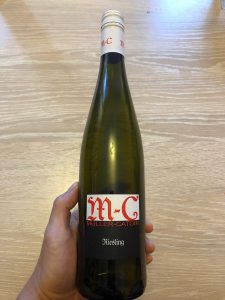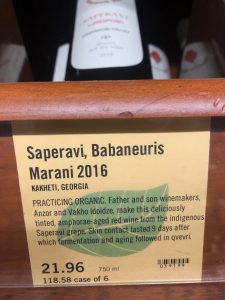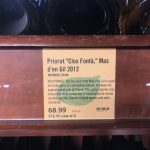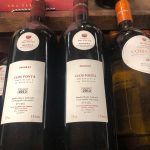On a chilly day in October, I visited two wineries in the Hamptons on Long Island, Wölffer Estate Vineyard and Duck Walk Vineyards. Both wineries are located in the Southampton area. The climate on Long Island is maritime, with cool weather and ocean breezes. The Hamptons A.V.A. was officially established in 2001.
Our first stop was Wölffer Estate Vineyard, one of the best-known wineries on Long Island. On first impression, the winery seemed very stylish, but also very touristy. Wölffer Estate’s labels and bottle designs are different from traditional wines in that they utilize a lot of color and pictures on the bottles, which give their wines a pop culture look. I first decided to visit Wölffer Estate Vineyard because it came with high recommendations from friends and colleagues. I appreciated that Wölffer Estate is trying to be “different” and to stand out from the competition. Upon entering the winery, one can immediately see a set of huge tanks through a window, where Wölffer Estate fermentsits wines. Upon passing this area, there is a gift shop on the left where one can buy Wölffer Estate wines and other goods. The narrow hallway opens to a large dining hall area designed for sampling wines over fresh prepared snacks with friends.
Wölffer Estate offers a tour and wine tasting for $65 per person. During the tour, the guide showed us the property and the cellar downstairs, while sharing information about Wölffer Estate’s history and wine. One thing I specifically liked about Wölffer Estate’s wine is that they use French oakfor several varieties of red wine when aging.Even though Wölffer Estate is perhaps most famous for its Rose, they still putting a lot of effort into their other wines. While the tour and tasting was enjoyable, Wölffer Estate was not my favorite winery. I sampled two different tastings, the Autumn Flight and the Grand Flight, as well as their sparkling rose, but I could not find a favorite wine from the tasting. For instance, while the Grapes of Roth Dry Riesling (2017)was my favorite from this tasting, overall I thought the wine was just okay. The wine is crisp and has a hint of sweetness, but I prefer a more full-bodied wine. I also tried their Claletto Cabernet Sauvignon(2014) that uses the “Amarone” style, meaning the wine is made from partially dried grapes. The wine, which had notes of blackberries, plum and the aroma of French oak, tasted a bit too complex for me.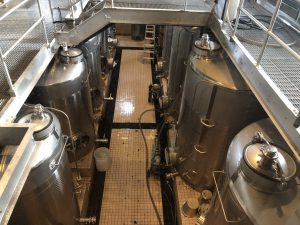
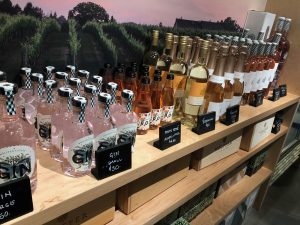
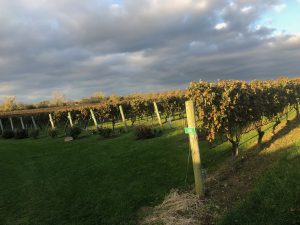
Following my visit to Wölffer Estate, I visited a smaller winery called Duck Walk Vineyards, located a quick ten-minute drive from Wölffer Estate. Originally, my group was not planning to visit this vineyard, but since Wölffer Estate left us feeling a bit disappointed, we decided make a brief stop at Duck Walk. Duck Walk Vineyard was established in 1994. Their flagship location is in Southampton, but they also have another location on North Fork, Long Island, which opened in 2007. Duck Walk owns 140 scenic acres and produces 35,000 cases of wine per year. Their flagship location features 36 acres of grapes, which sit behind a Normandy Chateau-style building in the township of Water Mill. Though it was certainly less stylish and more understated than Wölffer Estates, I personally liked Duck Walk’s building more because it was welcoming with a warm vibe. Their varieties of grapes include Chardonnay, Pinot Meunier, Melot, Pinot Grigioand more. My group did a tasting at their bar. A tasting at Duck Walk costs $10 for four samples. One can pick any four wines from their broad menu and will receive a generous pour. The bartender was very friendly and knowledgeable about Duck Walk’s wines. When I asked him what is “reserve” means with respect to the Cabernet Sauvignon Reserve (2015)(my favorite wine of the tasting), he explained that the reserve means the better grape juice from first flow, or the “free flow. The wine has intense fruit notes such as black cherry and plum, and a very smooth finish. When I told the bartender I was doing research for a class, he introduced me to Mike, who is extremely knowledgeable about wine and about Duck Walk Vineyards. He gave us a quick tour of the grounds. He first told us about the building. The bricks are from Mexico, sand blasted for a weathered look, and entire roof is copper. He then pointed out the tanks that they use for fermentation. The stainless steel tanks hold 5,373 gallons of liquid. Because they are made from stainless steel, they are easy to clean and keep impurities out of the wine. Additionally, each tank has a dimpled jacket, which helps control the temperature of the tanks. Duck Walk does also use seasoned oak barrelsfor aging for some wines, such as their Duck Walk Red Gatsby.
While both Wölffer Estate Vineyard and Duck Walk Vineyard were enjoyable to visit, I much preferred my experience at Duck Walk Vineyard to Wölffer Estate. The staff at Duck Walk were extremely friendly, knowledgeable about their craft and, perhaps most importantly, seemed truly passionate about sharing their wine with guests. Our experience at Wölffer Estate was quite different. In addition to overall better wine, Duck Walk also had a more affordable price range. Overall, I would recommend Wölffer Estate for an outdoor gathering with friends or family during the warm season, and I would recommend Duck Walk Vineyard for a friendly and educational wine sampling and purchasing experience.
References
Andrews, B. (2017, August 02). How Library Wines Help Build a Legacy. Retrieved from https://daily.sevenfifty.com/how-library-wines-help-build-a-legacy/
Certified specialist of wine: Study guide 2018. (2018). Washington, DC: Society of Wine Educators.
GOLDBERG, H. G. (1994, April 03). L.I.’s Largest Winery Bets on the South Fork. Retrieved from https://www.nytimes.com/1994/04/03/nyregion/li-s-largest-winery-bets-on-the-south-fork.html
Wines. (n.d.). Retrieved from http://liwines.com/wines/


